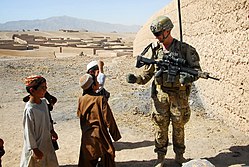Battle rifle
A battle rifle is a service rifle chambered to fire a fully powered cartridge.[1]
The term "battle rifle" is a
History
World War I
Semi-automatic
First examples of semi-automatic fully powered-cartridge rifles used in World War I are the Meunier A6, Fusil Automatique Modèle 1917 in 8×50mmR Lebel and the Winchester Model 1910 in .401 Winchester Self-Loading.

Select fire

During

France developed the Chauchat-Ribeyrolles 1918 submachine gun, an automatic shortrifle chambered in 8×50mmR Lebel, intended to defend tank crews.
World War II
The battle rifle was of major significance during
M1 Garand

At the outbreak of World War Two, the United States was the only nation in the world to have formally adopted a battle rifle as their service rifle. The M1 Garand fired the .30-06 Springfield cartridge, which loaded from an eight-round en bloc clip. When empty, this clip would eject upwards out of the rifle, making a distinctive ping sound in the process, after which a new en bloc clip could be inserted into the rifle. The adoption of the semi-automatic rifle allowed American riflemen to field much greater sustained firepower than their Allied and Axis contemporaries, who were still using bolt-action rifles as their primary rifle. The Garand continued to see front line service during the Korean War, saw limited service during the Vietnam War, and served as the basis for the creation of the M14 rifle.
SVT-40

The Soviet Union issued one major battle rifle, the
FG-42
Gewehr 41 and 43

Another German design built during the Second World War was the
Type 4

During the Pacific War, the Empire of Japan created the Type 4 rifle, also known as the Type 5, to act as a counter to the American M1 Garand. While initial attempts were made as rudimentary copies of the Garand, it was found that the Japanese 7.7×58mm Arisaka cartridge didn't respond well to being fitted into the Garand's internals, and so, the en-bloc clip design of the Garand was replaced with a 10-round internal magazine, loaded with stripper clips, as was seen in the German Gewehr 41. Only 250 were built, in 1945, when the Imperial Japanese Army was already at its breaking point, and production ceased with the surrender in August of that year.
Cold War
FN FAL

The most enduring battle rifle of the
Heckler & Koch G3

The '
M14

The
AR-10
The
Contemporary usage

After WW2, the USSR was the first global power to make an assault rifle the standard infantry weapon, with the

List of battle rifles
See also
- Assault rifle
- Automatic rifle
- Designated marksman rifle
- Fully powered cartridge
- Light machine gun
- List of firearms
- Sniper rifle
- 7.62×51mm NATO
- .30-06 Springfield
- 7.62×54mmR
- 7.92×57mm Mauser
- 6.5×50mmSR Arisaka
- .277 Fury
References
- ^ Charles Karwan (December 1999). "Military Guns Of The Century". Guns Magazine. Archived from [http.://findarticles.com/p/articles/mi_m0BQY/is_12_45/ai_57006135/ the original] on 2012-07-12.
- ISBN 978-1-59884-981-3.
- ISBN 978-1-4766-1564-6.
- ISBN 978-0-87364-297-2.
- ISBN 5-98655-006-4.)
{{cite book}}: CS1 maint: location missing publisher (link - ^ Rottman, Gordon (2007). Soviet Rifleman 1941–1945. Osprey Publishing. p. 25.
- ^ "SVT-38 SVT-40 Tokarev". Modern Firearms. 28 October 2010. Retrieved 13 August 2020.
- ^ Dugelby, Thomas (1990). Death from Above – the German FG42 Paratroop Rifle. Collector Grade Publications. pp. 3–4.
- ^ Dugelby, Thomas (1990). Death from Above. the German FG42 Paratroop Rifle. Collector Grade Publications. pp. 138, 143.
- ^ Aldis, Anne (2005). Soft Security Threats & Europe. Routledge. p. 83.
- ^ Bishop, Chris (1998). Guns in Combat. Chartwell Books, Inc.
- ISBN 83-11-09310-5.
- JSTOR resrep10728. Archived from the original(PDF) on June 29, 2017.
- ^ Kay, Bruce (10 June 1977). An Analysis of the Infantry's Need for an Assault Submachine Gun. p. 9.
- ISBN 1-84065-245-4.
- ^ Mikkelson, David (9 July 2002). "Were the M-16 Rifles Used During the Vietnam War Made by Mattel?". Snopes. Retrieved 6 September 2020.
- ISBN 9986-494-38-9.
- ISBN 9986-494-38-9.
- ^ "HK241: A DMR-System". Heckler & Koch. Archived from the original on 2017-10-08. Retrieved 14 August 2020.


